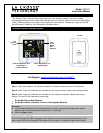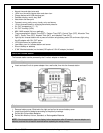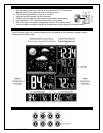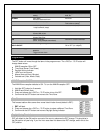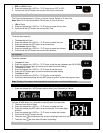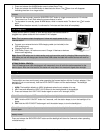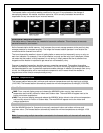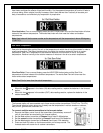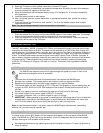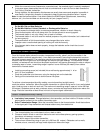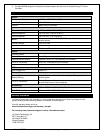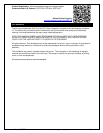
Model: C86371 www.lacrossetechnology.com/support 10
6. Press the TX button on each outdoor transmitter to transmit RF signal.
7. When RF connection is established, the respective temperature & humidity for each of the selected
channels numbers will appear on the main unit.
8. Allow the transmitters and the forecast station to stay 5-10 feet apart for 15 minutes to establish a
solid connection.
9. Install the battery covers on each sensor.
10. After 15 minutes place the remote transmitters in appropriate locations (see “position the outdoor
transmitter”).
11. Press and release the CH button to view channel 1, 2 or 3 on the forecast station when multiple
transmitters are used.
Note: You cannot change channels if only one transmitter is connected.
Channel Scroll
1. Press and release the CH button until the word AUTO appears in the outdoor data area. The forecast
station will automatically rotate through the channels for all connected transmitters.
2. Press and release the CH button to lock the forecast station into one channel. Then view channels
individually with a press of the CH button.
WWVB Radio-controlled Time
The NIST radio station, WWVB, is located in Ft. Collins, and transmits the exact time signal continuously
throughout the United States at 60 kHz. The signal can be received up to 2,000 miles away through the
internal antenna in the forecast station. However, due to the nature of the Earth’s Ionosphere, reception is
very limited during daylight hours. The forecast station will search for a signal every night when reception
is best. The WWVB radio station derives its signal from the NIST Atomic Clock in Boulder, Colorado. A
team of atomic physicists continually measures every second of every day to an accuracy of ten billionths
of a second a day. These physicists have created an international standard, measuring a second as
9,192,631,770 vibrations of a Cesium 133 atom in a vacuum. This atomic clock regulates the WWVB
transmitter.
WWVB Reception Icon
The WWVB time reception icon with full signal strength will appear on screen in front of the
date when the reception of time is successful.
The tower icon will show solid when the forecast station has received the WWVB signal.
No tower icon is shown. The forecast station was unable to receive a signal at this time.
Reposition the forecast station for better signal reception or try again at bedtime.
The forecast station will start searching at UTC: 07:00 and if no reception on the first attempt they will
try again at 08:00, 09:00 and 10:00. Each attempt will be at least 2 minutes and the most will be 10
minutes.
If there is no signal or too much interference the receiver will only be on for 2 minutes.
If the signal is good it may catch a signal in ABOUT 2-3 minutes.
If the signal is marginal it will try to catch a signal for up to 10 minutes.
IMPORTANT: When operating on a/c power, the backlight and USB charge port will turn off while the
forecast station searches for the WWVB signal, to avoid interference. Both features will return after
the 2-10 minute search which occurs during the late night or early morning hours.
Note: In case the forecast station is not able to detect the WWVB-signal (disturbances, transmitting
distance, etc.); the time may be manually set.
Manual Signal Search
In normal mode, hold the RCC button until the reception icon appears to force a search of the WWVB
signal. The WWVB icon will flash during the search. If this icon disappears after the 2-minute search,
the radio time signal is not available at the moment.
Recommended distance to any interfering sources like computer monitors or TV sets is a minimum of
6 feet (2 meters).



